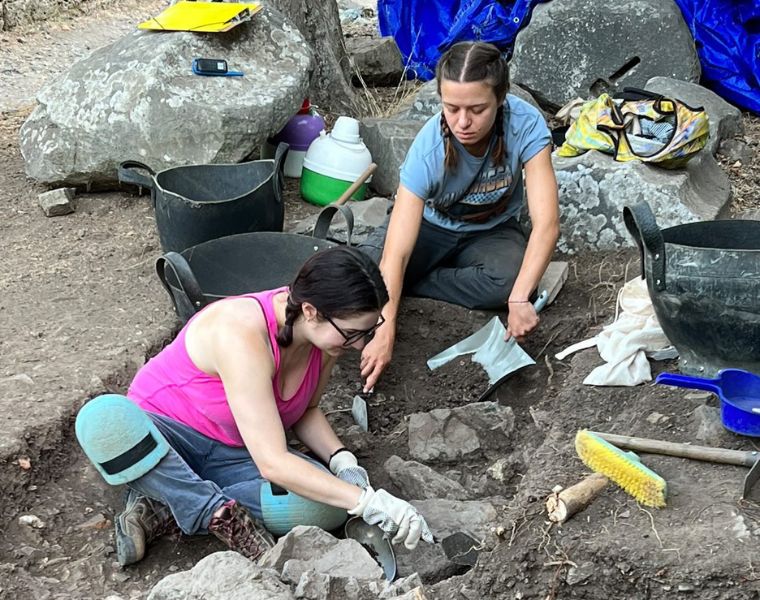Fifteen years ago as a graduate student, Maggie Popkin, the Robson Junior Professor and associate professor of art history, visited a small Greek island in the northern Aegean Sea. There, she formed lasting friendships that she’s maintained throughout her career.
This summer, Popkin returned to that very island, Samothrace, and brought with her a colleague and a team of Case Western Reserve University students who had the opportunity to not only foster similar connections, but to participate in American Excavations Samothrace, a global, interdisciplinary archaeological project.
Since 1938, American teams have excavated on the island, which is the original home to the Winged Victory of Samothrace, one of the most famous statues at the Louvre—but this year was the first time CWRU students had a hand in the project.
“In addition to the personal network that students form at Samothrace, working at an excavation offers a vital opportunity for students to understand the extraordinary diversity of disciplines that contribute to archaeology,” Popkin said. “[Participants can] understand the complex processes by which scholars go from objects and blocks of stone in the dirt to the theories and explanations we read in books and articles.”
Getting their hands dirty
Third-year Department of Art History and Art graduate students Arielle Suskin and Clara Pinchbeck can speak to Popkin’s experience. The pair took part in American Excavations Samothrace for seven weeks, working largely with the registar, conservation and survey teams, and even helping excavate.
In her role with the survey team, Pinchbeck supported the excavation through tasks such as plotting out new trenches and finds, mapping unmarked walls and ravines on the landscape, and using a magnetometer to explore buildings below the surface.
“Although hiking extensively for six days a week was hard work, being in the field was rewarding because we were perpetually exploring and re-exploring the island,” Pinchbeck explained. “Finding walls, coins, or pottery was just as informative for our interpretation of the site as hiking up to the top of the ancient city wall and looking down over the water.”
For Suskin, the most striking part about the experience was how much of ancient history has been lost over time—and how much work it is for excavators, archaeologists and art historians to put together what information they have from the objects and architecture still around and turn it into something comprehensible.
“You get to really understand how much work and skill it took people in the ancient world to create amazing cities and temples and the objects that populated them, and how lucky we are that so much survives today,” Suskin added. “It really helped me to understand that these places were cities, sanctuaries, homes, occupied by people and the experience of being in the same spaces, walking the same roads, [and] climbing the same stairs was really profound.”
Breaking ground
This summer, the team began excavating right outside the ancient entrance to the Sanctuary of the Great Gods, a space set along the massive walls that connected the sanctuary with the ancient city. They discovered a multi-room entrance complex with numerous cuttings in the walls for the insertion of steles, or inscribed upright marker stones.
This was the first time the American team has systematically excavated outside the sanctuary, according to Popkin.
“We are going to be able to understand so much better how the ancient city and sanctuary were connected, how people moved between them, and how the city walls acted as an extremely impressive site of display,” Popkin noted. “There were many more finds, but I think the city walls were a highlight and are going to be of immense interest going forward.”
Though they made new discoveries on the island, the impact of the CWRU team’s research trip will extend far beyond Samothrace. The experience allowed Popkin and Justine Howe, associate professor of religious studies and the chair of the Department of Religious Studies, to launch a collaborative project on embodied religion and mixed reality. The project—and their participation at Samothrace this summer—is funded by an Expanding Horizons Initiative Interdisciplinary (EHI) Grant from the College of Arts and Sciences.
As a scholar focused on contemporary religious practice, Howe said the trip was an exciting opportunity for her to “think through the deep connections between the ancient world and our present.”
“Prior to the trip, I had only experienced Samothrace and the Sanctuary of the Great Gods through HoloLens at [Kelvin Smith Library],” Howe added. “Now I am brimming with ideas about how human beings use technologies—whether through the rituals of mystery cults or the XR of the Metaverse—to create immersive environments that are rich in meaning and creativity.”
Popkin and Howe will bring these new ideas into their teaching and research through a course on extended reality and sacred space—also supported by the EHI Grant—that they’re co-teaching in the spring.
Learn more about American Excavations Samothrace and explore all the Department of Art History and Art has to offer.







